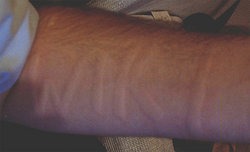Abstract
Localized heat induced urticaria is a rare clinical entity. Other physical urticarial subtypes include cholinergic, solar, cold, aquagenic, vibratory, and dermatographic. It is characterized by a well-demarcated urticarial lesion provoked by heat in direct contact with the skin. We describe a case of localized heat-induced urticaria in a 49-year-old woman after a heat-challenge test to her forearm.
**********
Case Report
A 49-year-old white female presented to our service with a 3- to 4-year history of pruritic, erythematous raised cutaneous lesions after direct contact with heat. She also noticed that her symptoms worsened each summer. Her symptoms were not associated with sunlight, exercise, pressure, cold, or vibration and she did not display dermatographism. She denied any systemic symptoms including dyspnea, nausea, flushing, abdominal pain, diarrhea, or syncopal episodes.
[FIGURE 1 OMITTED]
A heat-challenge test performed on her right arm was markedly positive (Figures 1, 2). Her laboratory data including CBC, LFT, TSH, and thyroid microsomal antibodies were all unremarkable. She was started on a trial of doxepin with moderate improvement. The addition of montelukast failed to make any additional gains in her treatment and was discontinued.
[FIGURE 2 OMITTED]
Discussion
Localized heat induced urticaria is a rare type of physical urticaria remarkable for its limited response to the site of heat exposure. Heat urticaria was first described by Duke in 1924 (1). He further categorized heat urticaria into local versus generalized in 1925 (2). According to Chang and Zic in 1999, there have been fewer than fifty reported cases of localized heat urticaria worldwide, predominantly exhibiting in females between the ages of 17 and 70 (3). The exact pathogenesis remains unclear, but can be attributed to the local release of histamine (4-6). Other mechanisms including the activation of the alternative complement pathway and release of prostaglandin D2 have also been suggested (7-9).
The classic whealing pattern seen in Figure 2 typically develops a few minutes after the threshold temperature is reached, ranging from 39[degrees]C to 56[degrees]C (3). Common triggers include warm water, heating pads, oven steam, hot utensils, hot plates, and hair dryers. The lesions are usually pruritic in sensation and localized to the site of exposure. Chang and Zic have reported systemic symptoms including wheezing, dyspnea, flushing, nausea, vomiting, abdominal pain, diarrhea, and syncope in up to 50% of patients (3).
It is important to distinguish this form of urticaria from other physical urticarias such as cold or solar urticaria. The diagnosis is best made by history and confirmed by a local heat challenge test. Localized heat urticaria, unlike solar urticaria, is dependent on the local temperature of the skin and unaffected by UV light. The other, more common type of heat urticaria is the generalized, cholinergic form. This is characterized by punctate urticarial lesions that arise in response to an increased core body temperature, or to emotional stress (1,2,10,11).
Excluding avoidance as a treatment option, H1 and H2 blockers, including systemic doxepin, have been used with varying success.
References
1. Duke WW. Urticaria caused specifically by the action of physical agents. JAMA 1924; 83:3-9.
2. Duke WW. Physical Allergy. JAMA 1925; 84:736.
3. Chang A. Zic JA. Localized heat urticaria. Journal of the American Academy of Dermatology 1999; 41:354-6.
4. Baba T. Nomura K. Hanada K. Hashimoto I. Immediate-type heat urticaria: report of a case and study of plasma histamine release. British Journal of Dermatology 1998; 138(2):326-8.
5. Grant JA, Findlay SR, Thueson DO, Fine DP, Krueger GG. Local heat urticaria/angioedema: evidence for histamine release without complement activation. Journal of Allergy & Clinical Immunology 1981; 67(1):75-7.
6. Greaves MW, Sneddon IB, Smith AK, Stanworth DR. Heat urticaria. British Journal of Dermatology 1974; 90:289-90.
7. Daman L. Lieberman P, Ganier M, Hashimoto K. Localized heat urticaria. Journal of Allergy & Clinical Immunology 1978; 61:273-8.
8. Johansson EA, Reunala T, Koskimies S, Lagerstedt A, Kauppinen K, Timonen K. Localized heat urticaria associated with a decrease in serum complement factor B (C3 proactivator). British Journal of Dermatology 1984; 110:227-31.
9. Koro O, Dover JS, Francis DM, et al. Release of prostaglandin D2 and histamine in a case of localized heat urticaria, and effect of treatments. British Journal of Dermatology 1986; 115:721-8.
10. Farnam J, Grant JA, Lett-Brown MA, Lord RA, Russell WL, Henry DP. Combined cold- and heat-induced cholinergic urticaria. Journal of Allergy & Clinical Immunology 1986; 78(2):353-7.
11. Hopkins JG, Kesten BM, Hazel OG. Urticaria provoked by heat or by psychic stimuli. Arch Dermat Syph 1938; 38:679.
CPT MATTHEW DARLING MC, U.S. AIR FORCE (1), CPT MATTHEW C LAMBIASE MC, U.S. ARMY (2), MAJ DARRYL S HODSON MC, U.S. ARMY (3)
1. DEPARTMENT OF SURGERY, WILFORD HALL MEDICAL CENTER, LACKLAND AFB, SAN ANTONIO, TEXAS
2,3. DEPARTMENT OF DERMATOLOGY, SAN ANTONIO UNIFORMED SERVICES HEALTH EDUCATION CONSORTIUM, FORT SAM HOUSTON, TEXAS
ADDRESS FOR CORRESPONDENCE:
CPT Matthew C Lambiase MC
Department of Dermatology
Wilford Hall Medical Center
2200 Bergquist Drive, Suite 1
Lackland AFB, TX 78236
Phone: 210-292-5373
Fax: 210-292-3781
E-mail: mattlambiase@yahoo.com
COPYRIGHT 2004 Journal of Drugs in Dermatology
COPYRIGHT 2004 Gale Group



